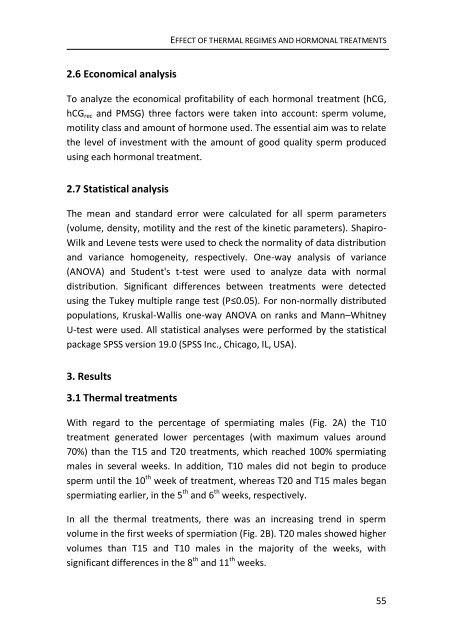chapter 3 - RiuNet
chapter 3 - RiuNet
chapter 3 - RiuNet
Create successful ePaper yourself
Turn your PDF publications into a flip-book with our unique Google optimized e-Paper software.
EFFECT OF THERMAL REGIMES AND HORMONAL TREATMENTS<br />
2.6 Economical analysis<br />
To analyze the economical profitability of each hormonal treatment (hCG,<br />
hCG rec and PMSG) three factors were taken into account: sperm volume,<br />
motility class and amount of hormone used. The essential aim was to relate<br />
the level of investment with the amount of good quality sperm produced<br />
using each hormonal treatment.<br />
2.7 Statistical analysis<br />
The mean and standard error were calculated for all sperm parameters<br />
(volume, density, motility and the rest of the kinetic parameters). Shapiro-<br />
Wilk and Levene tests were used to check the normality of data distribution<br />
and variance homogeneity, respectively. One-way analysis of variance<br />
(ANOVA) and Student's t-test were used to analyze data with normal<br />
distribution. Significant differences between treatments were detected<br />
using the Tukey multiple range test (P≤0.05). For non-normally distributed<br />
populations, Kruskal-Wallis one-way ANOVA on ranks and Mann–Whitney<br />
U-test were used. All statistical analyses were performed by the statistical<br />
package SPSS version 19.0 (SPSS Inc., Chicago, IL, USA).<br />
3. Results<br />
3.1 Thermal treatments<br />
With regard to the percentage of spermiating males (Fig. 2A) the T10<br />
treatment generated lower percentages (with maximum values around<br />
70%) than the T15 and T20 treatments, which reached 100% spermiating<br />
males in several weeks. In addition, T10 males did not begin to produce<br />
sperm until the 10 th week of treatment, whereas T20 and T15 males began<br />
spermiating earlier, in the 5 th and 6 th weeks, respectively.<br />
In all the thermal treatments, there was an increasing trend in sperm<br />
volume in the first weeks of spermiation (Fig. 2B). T20 males showed higher<br />
volumes than T15 and T10 males in the majority of the weeks, with<br />
significant differences in the 8 th and 11 th weeks.<br />
55
















